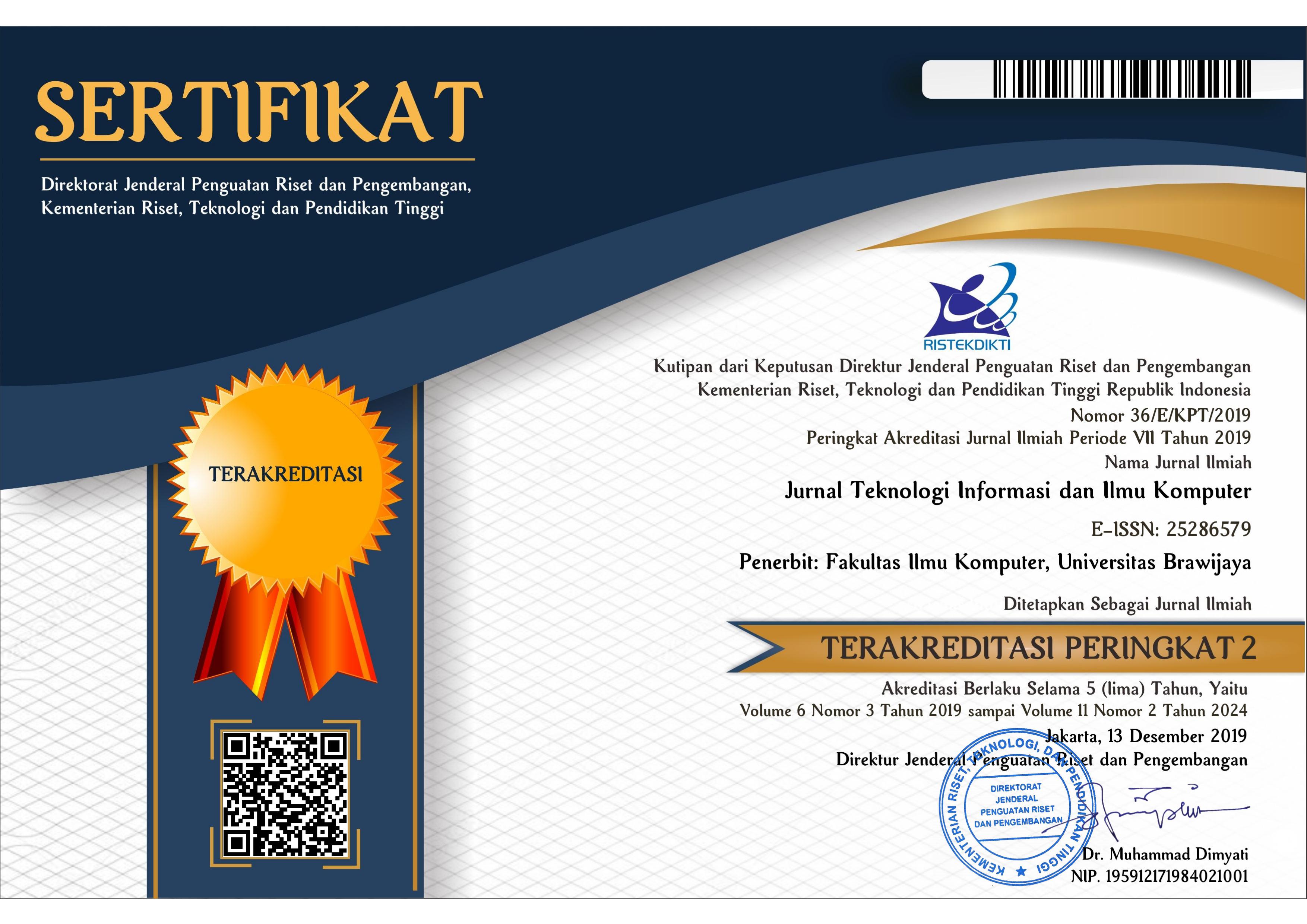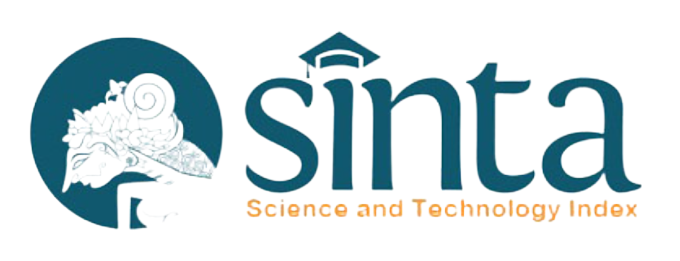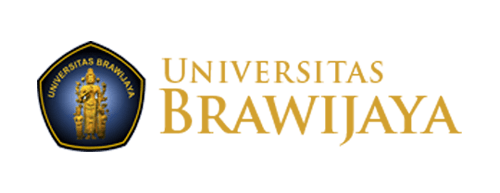Implementasi Algoritma Convolutional Neural Network untuk Klasifikasi Jenis Keris
DOI:
https://doi.org/10.25126/jtiik.937260Abstrak
UNESCO telah menetapkan Keris Indonesia sebagai Masterpiece of The Oral and Intangible Heritage of Humanity. Keris memiliki bilah yang terdiri dari Pamor, Dhapur, dan Tangguh yang merupakan istilah yang digunakan untuk menyebut nama bentuk dari bilah Keris. Dhapur Keris ada yang berbentuk lurus dan lengkok (Luk dalam bahasa jawa). Yang berbentuk luk, jumlahnya bermacam-macam, mulai dari luk 3 (tiga) sampai luk 29 (dua puluh Sembilan). Karena jenisnya yang banyak (sekitar 150 jenis yang diakui), bentuk Dhapur ini terkadang memiliki karakteristik yang mirip dan sulit dibedakan meskipun jenisnya berbeda. Untuk mengenali Dhapur Keris, perlu melakukan pengamatan pada Tabel ricikan Dhapur yang tentu saja sangat banyak dan harus memahami setiap detail Ricikan dengan benar. Hal ini menyebabkan tidak semua orang dapat mengenali Keris dengan mudah. Penelitian ini bertujuan membangun model pengenalan jenis Keris berdasarkan Dhapur dengan menggunakan citra Keris, sehingga tidak perlu mengamati Tabel Ricikan Dhapur. Metode Deep learning dengan algoritma Convolutional Neural Network (CNN) diimplementasikan untuk membangun model untuk klasifikasi jenis Keris berdasarkan Dhapur. Data Keris diambil secara manual dan maupun dari buku. Data citra terdiri dari 46 citra Keris yang terdiri dari dua kelas yaitu 10 Keris Parung Sari dan 36 Keris Tilam Upih. Validasi menggunakan 13 citra Tilam Upih dan 12 citra Parung Sari. Akurasi proses training sebesar 78,26% dan nilai validasi sebesar 52%. Hal ini menunjukkan bahwa masih perlu adanya peningkatan baik dalam teknik pengolahan maupun jumlah data.
Abstract
UNESCO designated Indonesian Keris as a Masterpiece of The Oral and Intangible Heritage of Humanity. Keris has blades consisting of Pamor, Dhapur, and Tangguh, which are terms used to name the shape of the Keris blade. There are straight and curved shape of Dhapur Keris (Luk in Javanese). The number of luk is varied, ranging from luk 3 (three) to luk 29 (twenty-nine). Because of its many types (around 150 recognized types), this form of Dhapur Keris sometimes has similar characteristics and is difficult to differentiate even though it is a different type. To recognize Dhapur Keris, it needs to observe Dhapur Ricikan table which of course consist of many types and must understand every detail of the ricikan correctly. This means that not everyone can recognize Keris easily. This research aims to build a model for recognizing Keris types based on Dhapur by using Keris images, so there is no need to observe the Dhapur Ricikan table. The Deep learning method with the Convolutional Neural Network (CNN) algorithm was implemented to build a model for classifying Keris types based on Dhapur. Keris data was taken manually and also from books. The image data consists of 46 Keris images consisting of two classes, namely 10 Parung Sari Keris and 36 Upih Tilam Keris. Validation used 13 images of Tilam Upih and 12 images of Parung Sari. The accuracy of the training process was 78.26% and the validation value was 52%. This shows that there is still a need to improve both processing techniques and the amount of data.
Downloads
Referensi
ADHI, B.P., WIDODO AND ANUGRAH, R.S., 2019. Indonesian Traditional Weapons Recognition Using Backpropagation. In: 1st 2018 Indonesian Association for Pattern Recognition International Conference, INAPR 2018 - Proceedings. pp.67–70. https://doi.org/10.1109/INAPR.2018.8627033.
BHATTACHARJEE, J., 2019. Practical machine learning with Rust: Creating intelligent applications in Rust. Practical Machine Learning with Rust: Creating Intelligent Applications in Rust. https://doi.org/10.1007/9781484251218.
BUDI, H. AND PETERZON, R., 2015. Hybrid Method and Similarity to Recognize Javanese Keris. International Journal of Advanced Computer Science and Applications, 6(9), pp.108–114. https://doi.org/10.14569/ijacsa.2015.060914.
DAMANIK, M., 2022. Aplikasi Pengenalan Identitas Gambar Dengan Menggunakan Metode Backpropagation. Journal of Informatics, Electrical and Electronics …, 1(3), pp.84–90.
HARAHAP, M., JEFFERSON, J., BARTI, S., SAMOSIR, S. AND TURNIP, C.A., 2020. Implementation of Convolutional Neural Network in the classification of red blood cells have affected of malaria. SinkrOn, 5(2), pp.199–207. https://doi.org/10.33395/sinkron.v5i2.10713.
HARYOGURITNO, H., 2005. Keris Jawa : Antara Mistik dan Nalar. Jakarta: Indonesia Kebanggaanku.
HERLANGGA, A., KARIM, R.R. AND NURWIJAYA, M.K., 2024. Penerapan Tansfer Learning EFFICIENTNETB3 untuk Pengenalan Senjata Tradisional Sumatera Barat menggunakan Convolutional Neural Network (CNN). 12(2), pp.1416–1423.
KOMUNITAS CINTA BUDAYA, 2022. Keris Indonesia for Peace and Humanity. Komunitas Cinta Budaya, .
KURONI, L.M.W. AND DARMAWAN, D.B.A., 2022. Identifikasi Dhapur Keris dengan Metode Convolutional Neural Network (CNN). Prosiding Seminar Nasional Universitas Ma Chung, [online] pp.110–119. Available at: <https://ocs.machung.ac.id/index.php/seminarnasionalmachung/article/view/291>.
KUSUMATATWA, K.I., SETIADI, A. AND NAGORO, K.S.D., 2021. Estetika Metafisika pada Seni Keris sebagai Media Pembelajaran. Journal of Contemporary Indonesian Art, 7(2), pp.74–89. https://doi.org/10.24821/jocia.v7i2.5501.
LUO, C., LI, X., WANG, L., HE, J., LI, D. AND ZHOU, J., 2019. How Does the Data set Affect CNN-based Image Classification Performance? In: 2018 5th International Conference on Systems and Informatics, ICSAI 2018. https://doi.org/10.1109/ICSAI.2018.8599448.
NURNANINGSIH, N., 2020. Keadiluhungan Keris dalam Budaya Jawa. Kawruh : Journal of Language Education, Literature and Local Culture, 2(2), p.145. https://doi.org/10.32585/kawruh.v2i2.1582
PURWANINGSIH, T., ANJANI, I.A. AND UTAMI, P.B., 2019. Convolutional Neural Networks Implementation for Chili Classification. Proceeding - 2018 International Symposium on Advanced Intelligent Informatics: Revolutionize Intelligent Informatics Spectrum for Humanity, SAIN 2018, pp.190–194. https://doi.org/10.1109/SAIN.2018.8673373.
SAPUTRA, O., MULYANA, D.I. AND YEL, M.B., 2022. Implementasi Algoritma Convolutional Neural Network (CNN) Untuk Klasifikasi Senjata Tradisional Di Jawa Tengah Dengan Metode Transfer Learning. Jurnal SISKOM-KB (Sistem Komputer dan Kecerdasan Buatan), 5(2), pp.45–52. https://doi.org/10.47970/siskom-kb.v5i2.282.
SETYADI, H.A., KUNCORO, D. AND PURNAMA, B.E., 2020. Expert system for identification dhapur of java keris. International Journal of Scientific and Technology Research, 9(1), pp.1763–1767.
SETYAWATI, E., 2018. Aplikasi Pengenalan Jenis Keris Tradisional dengan menggunakan Augmented Reality Berbasis Android. pp.590–595.
THE MATHWORKS, 2021. Introducing Deep Learning with MATLAB: ‘What is Deep Learning?’ The MathWorks, Inc. MATLAB and Simulink are registered trademarks of The MathWorks, Inc, pp.1–14.
WIBAWA, A.P., HANDAYANI, A.N., RUKANTALA, M.R.M., FERDYAN, M., BUDI, L.A.P., UTAMA, A.B.P. AND DWIYANTO, F.A., 2024. Decoding and preserving Indonesia’s iconic Keris via A CNN-based classification. Telematics and Informatics Reports, [online] 13(January), p.100120. https://doi.org/10.1016/j.teler.2024.100120.
Unduhan
Diterbitkan
Terbitan
Bagian
Lisensi
Hak Cipta (c) 2024 Jurnal Teknologi Informasi dan Ilmu Komputer

Artikel ini berlisensiCreative Commons Attribution-ShareAlike 4.0 International License.

Artikel ini berlisensi Creative Common Attribution-ShareAlike 4.0 International (CC BY-SA 4.0)
Penulis yang menerbitkan di jurnal ini menyetujui ketentuan berikut:
- Penulis menyimpan hak cipta dan memberikan jurnal hak penerbitan pertama naskah secara simultan dengan lisensi di bawah Creative Common Attribution-ShareAlike 4.0 International (CC BY-SA 4.0) yang mengizinkan orang lain untuk berbagi pekerjaan dengan sebuah pernyataan kepenulisan pekerjaan dan penerbitan awal di jurnal ini.
- Penulis bisa memasukkan ke dalam penyusunan kontraktual tambahan terpisah untuk distribusi non ekslusif versi kaya terbitan jurnal (contoh: mempostingnya ke repositori institusional atau menerbitkannya dalam sebuah buku), dengan pengakuan penerbitan awalnya di jurnal ini.
- Penulis diizinkan dan didorong untuk mem-posting karya mereka online (contoh: di repositori institusional atau di website mereka) sebelum dan selama proses penyerahan, karena dapat mengarahkan ke pertukaran produktif, seperti halnya sitiran yang lebih awal dan lebih hebat dari karya yang diterbitkan. (Lihat Efek Akses Terbuka).















